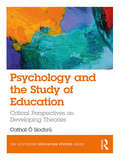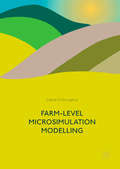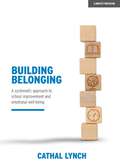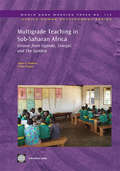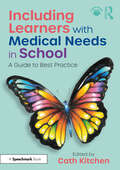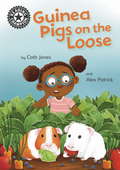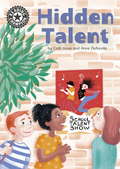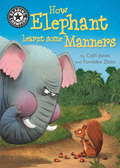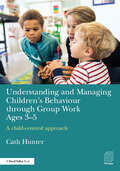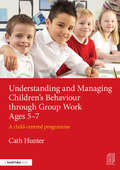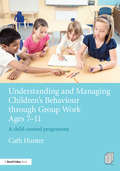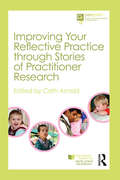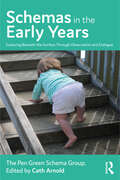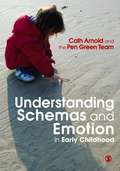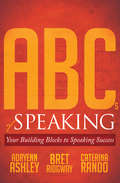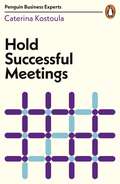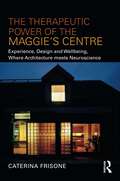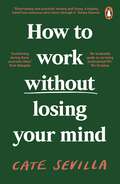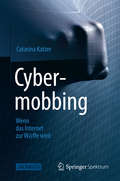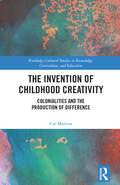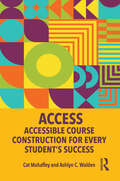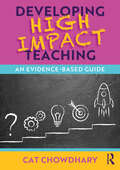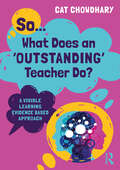- Table View
- List View
Psychology and the Study of Education: Critical Perspectives on Developing Theories (The Routledge Education Studies Series)
by Cathal Ó SiochrúPsychology and the Study of Education: Critical Perspectives on Developing Theories explores both the insights and applications that psychology can offer in a range of educational contexts. Introducing the reader to a wide variety of sources, from cutting edge research to key studies from the past, it offers new perspectives on the psychology of education. This includes re-examining core theories of learning, unpicking key learning processes and reconsidering the role of factors such as memory, creativity and gender in learning. Questioning myths and misconceptions, it challenges the reader to develop a critically reflective approach and asks them to reconsider the potential value of psychology in both understanding and influencing education. With discussion points and recommended readings provided in every chapter to enhance sessions and challenge students, issues explored include: Reconsidering what we think we know about the psychology of education. Memory: How we learn by remembering and imagining. Creativity: Creative learning and learning creativity. Reading, writing and dyslexia: Understanding the myths and exploring the challenges. Embodiment: The entanglement of brain, body and environment in learning. Social understanding: Learning to relate and its role in education. Gender: The origins of gender identity and its impact on education. Behaviourism: Taking a second look at its wider relevance to learning. Piaget: A fresh perspective on Piagetian theory and method. Vygotsky: Socio-cultural theories and collective learning. Your guide to the complex and evolving field that is psychology of education, this is an essential text for students of Education Studies, Disability Studies, Early Childhood or Childhood and Youth Studies and Teacher Education; ideal for anyone who has already been introduced to a little psychology and would like to know more, or anyone teaching psychology on an education course. Whether you are taking your first steps or looking for your next challenge, this book has something to offer anyone who wants to take their study of the psychology of education to the next level.
Farm-Level Microsimulation Modelling
by Cathal O'DonoghueThis book, which is the first to be published in the emerging field of farm-level microsimulation, highlights the different methodological components of microsimulation modelling: hypothetical, static, dynamic, behavioural, spatial and macro–micro. The author applies various microsimulation-based methodological tools to farms in a consistent manner and, supported by a set of Stata codes, undertakes analysis of a wide range of farming systems from OECD countries. To these case studies, O’Donoghue incorporates farming policies such as CAP income support payments, agri-environmental schemes, forestry planting incentives and biomass incentives – in doing so, he illuminates the merits of microsimulation in this environment.
Building Belonging: A systematic approach to school improvement and emotional well-being
by Cathal LynchBuilding belonging provides all the tools school leaders need to help unlock rapid school improvement by introducing The Emotional Wellbeing School Improvement Framework. Building on a robust evidence base it ensures everyone has a clear understanding of their collective destination by drawing on the views of all stakeholders to help ensure your organisation can prioritise objectives to best meet the needs of your young people. This is a practical, comprehensive guide to moving from unconscious to conscious competence in driving school improvement while protecting the emotional wellbeing of children and staff in a way that's proven to make a difference.Beginning with the genesis of the Framework this book gives readers a step-by-step guide to how to make it work in their own specific setting. The framework helps build capacity and the flexibility to support elsewhere as the direction of travel remains constant and everyone is clear about what they need to do, even if senior leaders move on. It also support succession planning as aspiring leaders know the systems and can step up much more smoothly.Crucially the framework does not dictate how to do things. It strives for aligned autonomy, meaning that leaders are free to draw on their contextual wisdom to inform their leadership actions and approaches while addressing the framework objectives.
Building Belonging: A systematic approach to school improvement and emotional well-being
by Cathal LynchBuilding belonging provides all the tools school leaders need to help unlock rapid school improvement by introducing The Emotional Wellbeing School Improvement Framework. Building on a robust evidence base it ensures everyone has a clear understanding of their collective destination by drawing on the views of all stakeholders to help ensure your organisation can prioritise objectives to best meet the needs of your young people. This is a practical, comprehensive guide to moving from unconscious to conscious competence in driving school improvement while protecting the emotional wellbeing of children and staff in a way that's proven to make a difference.Beginning with the genesis of the Framework this book gives readers a step-by-step guide to how to make it work in their own specific setting. The framework helps build capacity and the flexibility to support elsewhere as the direction of travel remains constant and everyone is clear about what they need to do, even if senior leaders move on. It also support succession planning as aspiring leaders know the systems and can step up much more smoothly.Crucially the framework does not dictate how to do things. It strives for aligned autonomy, meaning that leaders are free to draw on their contextual wisdom to inform their leadership actions and approaches while addressing the framework objectives.
Multigrade Teaching in Sub-Saharan Africa: Lessons from Uganda, Senegal, and the Gambia
by Cathal Higgins Aidan G. MulkeenIn Africa, with the expansion of coverage of primary education in recent decades, many of the remaining out-of-school children are in hard to reach areas, with low population density and poor transport. Providing access to education is challenging in such contexts, as the population in any village is often too small to support a conventional primary school. One of the answers is the use of multigrade teaching, where one teacher works with students of two or more grades. This paper examines the practice of multigrade teaching in three African countries, Uganda, Senegal, and The Gambia. Although these three cases had very different approaches to multigrade, their experiences suggest that multigrade teaching is a promising and cost-effective option, but that successful implementation requires sustained support from policymakers, adequate training of teachers, and careful explanation of the approach to parents and the communities.
Including Learners with Medical Needs in School: A Guide to Best Practice
by Cath KitchenThis accessible book is packed with information and strategies that will build your confidence in ensuring that children and young people with medical needs have equal access to education and can thrive academically, socially, and emotionally.Including Learners with Medical Needs in School provides school staff with a guide for best practice in supporting learners with complex health conditions in their schools. The book includes:• An overview of legal considerations and the responsibilities of schools and local authorities• How to create a welcoming environment and support the smooth reintegration to school following absences, as well as advice on managing medication and creating strong home–school partnerships• Guidance on working effectively with hospital schools, medical alternative provision, paediatric hospitals, and mental health units• A wealth of case studies, top tips, and tried-and-tested practical strategies that can be easily applied without huge costs or training• Signposting to further resources as well as downloadable specimen polices, exemplar Individual Healthcare Plans, and training materials.By implementing the recommendations in this book, schools can make a commitment to inclusion and make a real difference to the educational experience of children with medical needs. It is essential reading for SENCOs, pastoral leads, and senior leaders, as well as a useful resource for school governors and school nurses.
Guinea Pigs on the Loose: Independent Reading 11 (Reading Champion #507)
by Cath JonesBecks has the responsibility of looking after the school guinea pigs for the weekend. She looks after them well, but those guinea pigs are just too tempted by next door's garden!Reading Champion offers independent reading books for children to practise and reinforce their developing reading skills.Fantastic, original stories are accompanied by engaging artwork and a reading activity. Each book has been carefully graded so that it can be matched to a child's reading ability, encouraging reading for pleasure.Independent Reading 11 stories are the perfect introduction to first chapter books for children aged 6+ who are reading at book band 11 in classroom reading lessons.
Hidden Talent: Independent Reading 15 (Reading Champion #326)
by Cath JonesIt's the school talent show, and a famous celebrity is coming to judge. Max's friends are excited and long to take part, but Max feels far too shy. Friendship and understanding help her work through and ultimately overcome her anxiety.This first colour chapter book is a perfectly levelled, accessible text for Key stage 2 readers aged 9-10. Reading Champion offers independent reading books for children to practise and reinforce their developing reading skills.Fantastic, original stories are accompanied by engaging artwork and activities to provoke deeper response and encourage writing. Each book has been carefully graded so that it can be matched to a child's reading ability, encouraging reading for pleasure.The Key Stage 2 Reading Champion Books are suggested for use as follows:Independent Reading 11: start of Year 3 or age 7+Independent Reading 12: end of Year 3 or age 7+Independent Reading 13: start of Year 4 or age 8+Independent Reading 14: end of Year 4 or age 8+Independent Reading 15: start of Year 5 or age 9+Independent Reading 16: end of Year 5 or age 9+Independent Reading 17: start of Year 6 or age 10+Independent Reading 18: end of Year 6 or age 10+
How Elephant Learnt Some Manners: Independent Reading 12 (Reading Champion #511)
by Cath JonesThis story is part of Reading Champion, a series carefully linked to book bands to encourage independent reading skills, developed with Dr Sue Bodman and Glen Franklin of UCL Institute of Education (IOE). This book is aimed at Independent Reading 12, for readers aged 7 years old and up, or in the second half of Year 3.Elephant is the biggest and also thinks he's the best. He's always a bit rude to the other animals, until some clever squirrels teach him a lesson.Reading Champion offers independent reading books for children to practise and reinforce their developing reading skills.Fantastic, original stories are accompanied by engaging artwork and a reading activity. Each book has been carefully graded so that it can be matched to a child's reading ability, encouraging reading for pleasure.The Key Stage 2 Reading Champion Books are suggested for use as follows:Independent Reading 11: start of Year 3 or age 7+Independent Reading 12: end of Year 3 or age 7+Independent Reading 13: start of Year 4 or age 8+Independent Reading 14: end of Year 4 or age 8+Independent Reading 15: start of Year 5 or age 9+Independent Reading 16: end of Year 5 or age 9+Independent Reading 17: start of Year 6 or age 10+Independent Reading 18: end of Year 6 or age 10+
Understanding and Managing Children's Behaviour through Group Work Ages 3-5: A child–centred approach
by Cath HunterUnderstanding and Managing Children’s Behaviour through Group Work Ages 3-5 provides the reader with an insight into children’s emotional well-being and helps them to understand what and how children communicate and how to respond in a way that provides positive messages, increases their emotional vocabulary and encourages them to change their behaviour. It provides an alternative and effective child centred way of managing children’s behaviour through introducing the concept of reflective language and other tools, equipping staff with new skills that are transferable across the school in any role. The book is divided into two sections, enabling the reader to link theory with practice. The first section takes the reader on a journey to help them understand the different factors that influence children’s behaviour. The second section of the book focuses on the group work programmes, how they can be used, their value and the impact they can have on children and the classroom environment as a whole. The activities in the group work programme explore the concept of using reflective language as a behaviour management tool and are designed to motivate, build confidence, self-esteem and resilience. Useful pedagogical features throughout the book include:- Practitioner and classroom management tips and reflective tasks; Strategies and practical ideas for staff to use to help them engage more deeply with the contents of the book; Flexible, tried and tested group work programmes designed to promote inclusion rather than exclusion; Clear step by step instructions for delivering the work programmes; Case studies showing behaviour examples with detailed explanations for the behaviour and strategies to respond to it. The book is aimed at all early years practitioners and any students training to work with children of E.Y.F.S age. It is also recommended reading for SENCOs and trainee teachers and will also be useful for therapists who work with children and are looking at delivering other approaches in their work.
Understanding and Managing Children's Behaviour through Group Work Ages 5-7: A child-centred programme
by Cath HunterUnderstanding and Managing Children’s Behaviour 5-7 provides the reader with an insight into children’s emotional well-being and helps them to understand what and how children communicate and how to respond in a way that provides positive messages, increases their emotional vocabulary and encourages them to change their behaviour. It provides an alternative and effective child-centred way of managing children’s behaviour through introducing the concept of reflective language and other tools, equipping staff with new skills that are transferable across the school in any role. The book is divided into two sections, enabling the reader to link theory with practice. The first section takes the reader on a journey to help them understand the different factors that influence children’s behaviour. The second section of the book focuses on the group work programmes, how they can be used, their value and the impact they can have on children and the school as a whole. The activities in the group work programmes explore the concept of using reflective language as a behaviour management tool and are designed to motivate and build confidence, self-esteem and resilience. Useful pedagogical features throughout the book include: practitioner and classroom management tips and reflective tasks; strategies and practical ideas for staff to use to help them engage more deeply with the contents of the book; flexible, tried and tested group work programmes designed to promote inclusion rather than exclusion; clear step-by-step instructions for delivering the group work programmes; case studies showing behaviour examples with detailed explanations for the behaviour and strategies to respond to it. This book is aimed at all KS1 primary school staff, especially teaching assistants, learning mentors and family workers who can deliver the group work programmes. It is also recommended reading for SENCOs and trainee teachers, and will be useful for therapists who work with children and are looking at delivering other approaches in their work.
Understanding and Managing Children's Behaviour through Group Work Ages 7 - 11: A child-centred programme
by Cath Hunter'I would highly recommend the skills, expertise and delivery that Cath can bring to a school and can guarantee that any school following her advice will not regret it.' Carl McIver, Head of School, St. Willibrord's R.C. Primary, Manchester 'I have worked with Cath Hunter now in two schools and find that the work she does with children, parents and staff is amazing.' Sam Foord, Headteacher, Ravensbury Community School, Manchester Understanding and Managing Children’s Behaviour provides the reader with an insight into children’s emotional wellbeing and helps them to understand what and how children communicate and how to respond in a way that provides positive messages, increases their emotional vocabulary and encourages them to change their behaviour. It provides an alternative and effective child centred way of managing children’s behaviour through introducing the concept of reflective language and other tools, equipping staff with new skills that are transferable across the school in any role. The book is divided into two sections, enabling the reader to link theory with practice. The first section takes the reader on a journey to help them understand the different factors that influence children’s behaviour. The second section of the book focuses on the group work programmes, how they can be used, their value and the impact they can have on children and the school as a whole. The activities in the group work programme explore the concept of using reflective language as a behaviour management tool and are designed to motivate, build confidence, self-esteem and resilience. Useful pedagogical features throughout the book include:- Practitioner and classroom management tips and reflective tasks; Strategies and practical ideas for staff to use to help them engage more deeply with the contents of the book; Flexible, tried and tested group work programmes designed to promote inclusion rather than exclusion; Clear step by step instructions for delivering the work programmes; Case studies showing behaviour examples with detailed explanations for the behaviour and strategies to respond to it. The book is aimed at all primary school staff, especially teaching assistants, learning mentors and family workers who can deliver the group work programmes. It is also recommended reading for SENCOs and trainee teachers and will also be useful for therapists who work with children and are looking at delivering other approaches in their work.
Improving Your Reflective Practice through Stories of Practitioner Research (Pen Green Books for Early Years Educators)
by Cath ArnoldImproving Your Reflective Practice through Stories of Practitioner Research shows how research has informed and created effective and valuable reflective practice in early years education, and offers depth to the arguments for a research-orientated stance to this vital field of study. This thought-provoking text explores and documents a variety of small-scale practitioner research projects from the home and early years settings. The stories are centred around real life for children, families and workers and offer practical ideas and support for early years students around the world. They engage in some of the most current debates in early childhood education today, such as: how to support children as individuals how young children learn and how parents support their learning how to lead and facilitate change in a way that does not take power away from children, parents or workers how to support children in taking risks how to support parents in returning to learning. Throughout this book, the ‘Pen Green’ attitude to practitioner research is actively encouraged. This involves fostering curiosity, being open to the views of others, questioning the ‘taken for granted’, making the implicit explicit and reflecting on one’s daily work. Any practitioner research in early years education and care will draw inspiration from this accessible and supportive text.
Schemas in the Early Years: Exploring Beneath the Surface Through Observation and Dialogue
by Cath ArnoldEvolved through conversations with key early childhood education experts, Schemas in the Early Years focuses on the value of ‘repeated patterns’ of action or ‘schemas’ in young children’s play. It stimulates readers to ask questions of themselves, to watch children closely, and to create a dialogue with parents and other educators as well. Contributors to this fascinating book discuss their observation of children in naturalistic situations when they are deeply involved in play and identify topics or themes that can be linked to and inspire professional development opportunities. This book provides an antidote to beginning with the curriculum rather than the child and really considers children as learners. Each chapter focuses on young children and schemas, considering a wide age range from babies to children attending statutory schooling. Schemas in the Early Years is an accessible and inspiring text and serves as essential reading for educators wanting to think further and in more depth about schemas. Newcomers to schema theory or anyone currently using schema theory to understand children will also find these enquiries useful. All royalties from the sale of this book will be donated to Shelter – the housing and homelessness charity.
Understanding Schemas and Emotion in Early Childhood
by Cath ArnoldThis book makes explicit connections between young children's spontaneous repeated actions, and their representations of their emotional worlds. Drawing on the literature on schemas, attachment theory and family contexts, the author takes schema theory into the territory of the emotions, making it relevant to the social and emotional development strand in early childhood education. Based on research carried out alongside children, parents, workers and co-researchers at the world-famous Pen Green Nursery, and using case studies of a small number of individual children, the author shows new links between cognition and affect. The book includes a brief summary of a method of Child Study, using video and reflections on video sequences. This book will be of interest to students and practitioners on Early Childhood undergraduate and postgraduate courses, as well as those taking modules on schema theory.
ABCs of Speaking: Your Building Blocks to Speaking Success
by Caterina Rando Adryenn Ashley Bret RidgwayAn A–Z primer for all levels of public speaking, from securing engagements to delivering unforgettable speeches to making money as a speaker. Can you make it as a professional speaker? Knowing how to deliver a great presentation is obviously important, but truly understanding how the speaking industry really works is probably even more important. What do you need to know to deal with event promoters? What can you do to take control of the room and not let the unexpected derail your presentation? Should you pursue the fee or free speaking model? What about technology? What do they mean by &‘buying units.&’ Industry insiders Adryenn Ashley, Bret Ridgway, and Caterina Rando share their combined decades of experience from both the platform and the promoter perspectives. They pull back the curtains and give you a sneak peek into how the speaking world really works. You&’ll learn how to build a profitable speaking business that allows you to more effectively build your platform and share your powerful message with the world. Even if you already consider yourself a professional speaker, you&’re guaranteed to pick up a few nuggets that can help you take things to the next level with your speaking. Get more gigs, make more money and impact more lives today!
Hold Successful Meetings (Penguin Business Experts Series)
by Caterina KostoulaMeetings allow us to bring people together to inspire each other, solve problems and make a difference. Yet, we all spend too much time in dull, frustrating meetings where little is achieved and even less is followed up on afterwards. In Hold Successful Meetings, executive coach and former Google leader Caterina Kostoula will change all this. Her unique framework will:- Equip you to hold fewer, more purposeful meetings- Create a creative and inclusive environment- Leave participants inspired and ready to take actionWhether virtual or in-person, people will leave your meetings inspired by the value you created together and ready to make an impact.'I bought this for my whole team at Google!' Reader review
The Therapeutic Power of the Maggie’s Centre: Experience, Design and Wellbeing, Where Architecture meets Neuroscience
by Caterina FrisoneThis book is about the therapeutic environment of the Maggie’s centre and explores the many ways this is achieved. With an unconventional architecture as required by the design brief, combined with Maggie’s psychological support programme, this special health facility allows extraordinary therapeutic effects in people, to the point that one can speak of therapeutic power.After tracing the story of the Maggie’s centre, the book reveals its fundamentals: Maggie’s Therapeutikos (the-mind-as-important-as-the-body), the Architectural Brief and the ‘Client-Architect-Users’ Triad. It continues by unfolding Maggie’s synergy-that between people and place-which increases users’ psychological flexibility helping them tolerate what was intolerable before. Although comfort and atmospheres are paramount, they are not enough to define the therapeutic environment of the Maggie’s centre. Only by looking at neuroscience that can give us scientific explanations of empathy, feelings and emotions and only considering space neither neutral nor empty, but full of forces that envelop people in an embodied experience, can we explain what generates wellbeing in a Maggie’s centre.The book concludes by critically evaluating the Maggie’s centre as a model to be applied to other healthcare facilities and to architecture in general. It is essential reading for any student or professional working on therapeutic environments.
How to Work Without Losing Your Mind
by Cate Sevilla'Genuinely empowering' Daisy Buchanan'An invaluable guide to surviving professional life' Viv Groskop'Comforting during these uncertain times' Yomi AdegokeAward-winning journalist and editor-in-chief Cate Sevilla has survived the messy, stressy and sometimes bizarre world of work - just.In How to Work Without Losing Your Mind, she gives an unflinchingly honest account of the bad bosses, the time spent crying in work loos, the hell and humiliation of her working life but, most importantly, she reveals the solid self-belief, the sage advice and the hard-won lessons that got her through.Filled with humour, wit and supportive words, this book is your essential guide to fixing your relationship with your work. Press it into the hands of every womxn who is sinking in a toxic work environment, battling burnout, recovering from redundancy or trying to find the right career fit. 'Entertaining and practical; moving and funny; a helping hand from someone who's been through it' Emma Gannon, Sunday Times bestselling author
Cybermobbing - Wenn das Internet zur W@ffe wird
by Catarina KatzerDie Nutzung von Internet-Chatrooms und sozialen Netzwerken wie z. B. Facebook sind mittlerweile die wichtigsten Kommunikationsformen für Kinder und Jugendliche im Cyberspace. Unter der Bedingung vollkommener physischer Anonymität, d. h. ohne zu wissen, wer tatsächlich hinter diesen Chatpartnern steckt, können Teilnehmer aufgrund der synchronen Interaktion ohne Zeitverzögerung mit anderen ,,chatten". Dadurch sinkt die Hemmschwelle für bösartige Attacken und Gemeinheiten anderen gegenüber. Es entsteht das ideale Umfeld für Cybermobbing So werden Eltern, Jugendliche, Lehrer, Pädagogen, Psychologen, Jugendsozialarbeiter oder Streetworker vor neue Herausforderungen gestellt. Sie sind mit dem Internet als neuem Tatort für Phänomene aus dem schulischen Alltag und dem physischen Umfeld konfrontiert. Diese schwierige Aufgabe wird oft durch den Mangel an Erfahrungen in diesem neuen Problembereich erschwert Das wesentliche Ziel dieses Buches besteht darin, aufzuklären und sinnvolle Antworten auf folgende Fragen zu geben: Wie ist auf Cybermobbing zu reagieren? Wer sind die Täter und wer sind die Opfer? Was können wir präventiv gegen Cybermobbing tun? Es wird Eltern, Lehrer und Jugendliche, sowie alle anderen Interessierten darüber informieren, was in Online-Foren, sozialen Netzwerken, Chatrooms und Videoportalen überhaupt passiert, welche psychischen und psychosomatischen Auswirkungen dies auf die Opfer haben kann und was Freunde, Eltern und Lehrer dagegen tun können. Somit schlägt es eine Brücke zwischen den Jugendlichen Digital Natives und den Erwachsenen Digital Immigrants.
No me conoces pero soy tu mejor amigo
by Cata KaoeLa novela juvenil de romance, misterio, y humor éxito en Wattpad, escrita por Cata Kaoe. La mayoría del tiempo, a Álex, un estudiante gruñón y asocial de 16 años, su mejor amiga Solae le parece fastidiosa. No sabe valorar su cariño hasta que aparece Anton, un desconocido que se convierte en la nueva persona favorita de Solae y ella olvida por completo que alguna vez tuvo una amistad con Álex. Angustiado, él es el único que recuerda que fueron amigos y hace todo lo posible para desenmascarar a Anton, quien lo está suplantando, pero él no se lo hace nada de fácil: le advierte que en el TRI, la fiesta más importante del año, perderá a su amiga para siempre. ¿Podrá Álex recuperar la amistad de Solae?
The Invention of Childhood Creativity: Colonialities and the Production of Difference (Routledge Cultural Studies in Knowledge, Curriculum, and Education)
by Cat MartinsThis text offers a comprehensive analysis of the concept of the modern creative and imaginative child in Western education. Drawing on archived sources and historical works, it reframes childhood creativity as a social, cultural, and scientific construction, asking how our thinking and acting toward the creative child have been produced historically. The text dissects the discursive construction of creativity as a natural and developmental attribute of the child. It argues that the idea of the White creative child, constructed through comparative reasoning, shaped by primitivism, and illustrated through botanical metaphors as close to nature and the senses, is a notion embedded with colonialities, forming part of a Western civilizing project and entrenched power-knowledge relations. A compelling and original account of childhood creativity, this text will appeal to researchers in arts education, early childhood education, curriculum studies, and the history of education.
ACCESS: Accessible Course Construction for Every Student’s Success
by Cat Mahaffey Ashlyn C. WaldenACCESS: Accessible Course Construction for Every Student’s Success is a practical guide to digital course design that incorporates and exceeds current accessibility practices for disabled and non-disabled students in higher education. Today’s rapid proliferation of online, blended, and hybrid learning systems has alerted college and university staff to unforeseen yet urgent lapses in accommodating students’ various learning needs and preferences. This book offers a wealth of learning design and delivery strategies that meaningfully address the notions of accessibility that move beyond compliance with the Americans With Disabilities Act (ADA). Each chapter explores accessibility in a situated context, making this an ideal resource for instructional design students and professionals, learning scientists, disability support personnel, and faculty developing their own digital courses.
Developing High Impact Teaching: An Evidence-Based Guide
by Cat ChowdharyThis vital book delves into key teaching strategies that drive student progress and enhance classroom learning. Both accessible and practical, it demonstrates how building routines and structures allows teachers to have a lasting positive impact on student’s learning and offers the tools to ensure students feel supported and engaged throughout their learning journey.Working as a practical guide for teachers at all stages, these chapters delve into topics such as delivering clear instructions, fostering metacognitive skills, assessing progress effectively, and leading impactful learning. Developing High Impact Teaching offers valuable advice on how to develop your students as active learners and participants in their own education, how to set up impactful routines and good learning habits, how to give clear instructions so students understand what success looks like, and how to use cognitive acceleration techniques to improve learning. It is an essential resource for any busy classroom teacher or school.Designed with newly qualified teachers and those looking to refine their approach in mind, it emphasises evidence-based techniques rooted in Visible Learning principles. Through actionable advice and relatable insights, this book serves as an invaluable resource for educators seeking continuous growth and classroom success.
So... What Does an Outstanding Teacher Do?: A Visible Learning Evidence Based Approach
by Cat ChowdharyWhat distinguishes an Outstanding Teacher? A question asked in numerous interviews - and one that's much easier to ask than to answer. Many teachers will admit they don’t actually know what ‘Outstanding’ looks like. It's not about creating jazz hands lessons for a one-off observation, through 'prepping, stressing and box-ticking'. It isn’t something that can be achieved in a single lesson. It is a craft that needs developing like any other skill. This guide expands on previous works by discussing long-term development, the benefits of embedding skills, learner attributes and the impact of COVID. Influenced by John Hattie's Visible Learning research, So…What does an Outstanding Teacher Do? provides practical guidance and opportunities for self-reflection for teachers who want to maximise their positive impact on students’ learning. Areas covered include: Feedback Student voice Self-regulation Teachers working collectively Differentiated learning objectives SOLO Taxonomy Questioning and observation Chowdhary provides teachers with recommendations for enhancing practice that easily apply to any classroom, regardless of their subject, speciality or position. Whether you are a PGCE Student, an ECT or a practising teacher, this book is a practical and accessible guide for any teacher who aspires to maximise their positive impact and become truly outstanding.
